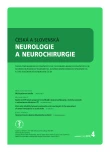Superior semicircular canal dehiscence
Authors:
Maja Stříteská 1-3
; O. Profant 1,4
; K. Trnková 1; M. Laboš 5; J. Weichet 5; Jana Dědková 6; M. Vališ 7; Viktor Chrobok 2
; Martin Chovanec 1
Authors‘ workplace:
Otorinolaryngologická klinika 3. LF UK a FN Královské Vinohrady, Praha
1; Klinika otorinolaryngologie a chirurgie hlavy a krku LF UK a FN Hradec Králové
2; ORL ambulance TINITUS s. r. o., Chrudim
3; Oddělení neurofyziologie sluchu, Ústav experimentální medicíny, AV ČR, Praha
4; Radiodiagnostická klinika 3. LF UK a FN Královské Vinohrady, Praha
5; Radiologická klinika LF UK a FN Hradec Králové
6; Neurologická klinika LF UK a FN Hradec Králové
7
Published in:
Cesk Slov Neurol N 2019; 82(4): 461-463
Category:
Letters to Editor
doi:
https://doi.org/10.14735/amcsnn2019461
Overview
Syndrome of superior semicircular canal dehiscence represents relatively rare disease of the inner ear. It presents with various combinations of often bizarre vestibular and hearing symptoms. The pathological and pathophysiological basis of this clinical syndrome is defect of otic capsule in the middle fossa. Dehiscence represents the third mobile window of the otic capsule. The purpose of the case report is to present characteristic neurootologic and audiologic symptomatology of the syndrome, key steps in its diagnosis and its surgical management.
The authors declare they have no potential conflicts of interest concerning drugs, products, or services used in the study.
The Editorial Board declares that the manu script met the ICMJE “uniform requirements” for biomedical papers.
Keywords:
superior semicircular canal dehiscence – Tullio phenomenon – vestibular evoked myogenic potentials – third window
Sources
1. Minor LB, Solomon D, Zinreich JS et al. Sound - and/or pressure-induced vertigo due to bone dehiscence of the superior semicircular canal. Arch Otolaryngol Head Neck Surg 1998; 124(3): 249–258.
2. Mau C, Kamal N, Badeti S et al. Superior semicircular canal dehiscence: diagnosis and management. J Clin Neurosci 2018; 48 : 58–65. doi: 10.1016/j.jocn.2017.11.019.
3. Chrobok V, Pellant A, Šimáková E et al. Cholesteatom a píštěl kostěného labyrintu. Otorinolaryng a Foniat 2005; 54(4): 193–198.
4. Carey JP, Migliaccio AA, Minor LB. Semicircular canal function before and after surgery for superior canal dehiscence. Otol Neurotol 2007; 28(3): 356–364.
5. Nadgir RN, Ozonoff A, Devaiah AK et al. Superior semicircular canal dehiscence: congenital or acquired condition? AJNR Am J Neuroradiol 2011; 32(5): 947–949.
6. Carey JP, Minor LB, Nager GT, Dehiscence or thinning of bone overlying the superior semicircular canal in a temporal bone survey. Arch Otolaryngol Head Neck Surg 2000; 126(2): 137–147.
7. Teixido M, Kung B, Rosowski JJ et al. Histopathology of the temporal bone in a case of superior canal dehiscence syndrome. Ann Otol Rhinol Laryngol 2012; 121(1): 7–12.
8. Brantberg, K, Bergenius J, Mendel L et al. Symptoms, findings and treatment in patients with dehiscence of the superior semicircular canal. Acta Otolaryngol 2001; 121(1): 68–75.
9. Zhou G, Gopen Q, Poe DS. Clinical and diagnostic characterization of canal dehiscence syndrome: a great otologic mimicker. Otol Neurotol 2007; 28(7): 920–926.
10. Lagman C, Ong V, Chung LK et al. Pediatric superior semicircular canal dehiscence: illustrative case and systematic review. J Neurosurg Pediatr 2017; 20(2): 196–203.
11. Halmagyi GM, Aw ST, McGarvie LA et al. Superior semicircular canal dehiscence simulating otosclerosis. J Laryngol Otol 2003; 117(7): 553–557.
12. Minor LB. Clinical manifestations of superior semicircular canal dehiscence. Laryngoscope 2005; 115(10): 1717–1727.
13. Ward BK, Carey JP, Minor LB. Superior canal dehiscence syndrome: lessons from the first 20 years. Front Neurol 2017; 8 : 177. doi: 10.3389/fneur.2017.00177.
14. Davey S, Kelly-Morland C, Phillips JS et al. Assessment of superior semicircular canal thickness with advancing age. Laryngoscope 2015; 125(8): 1940–1945.
15. Silverstein H, Kartush JM, Parnes LS et al. Round window reinforcement for superior semicircular canal dehiscence: a retrospective multi-center case series. Am J Otolaryngol 2014; 35(3): 286–293.
16. Silverstein H, Van Ess MJ. Complete round window niche occlusion for superior semicircular canal dehiscence syndrome: a minimally invasive approach. Ear Nose Throat J 2009; 88(8): 1042–1056.
Labels
Paediatric neurology Neurosurgery NeurologyArticle was published in
Czech and Slovak Neurology and Neurosurgery

2019 Issue 4
Most read in this issue
- Multiple system atrophy
- Superior semicircular canal dehiscence
- Spina bifida in the Czech Republic – incidence and prenatal diagnostics
- Hearing loss after spinal anesthesia
